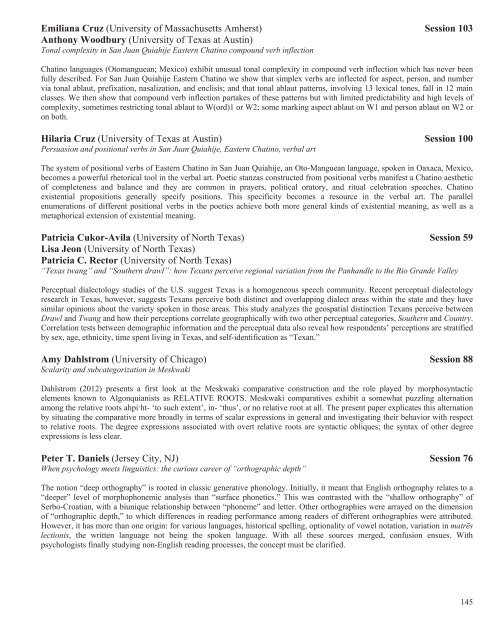here - Linguistic Society of America
here - Linguistic Society of America
here - Linguistic Society of America
You also want an ePaper? Increase the reach of your titles
YUMPU automatically turns print PDFs into web optimized ePapers that Google loves.
Emiliana Cruz (University <strong>of</strong> Massachusetts Amherst) Session 103Anthony Woodbury (University <strong>of</strong> Texas at Austin)Tonal complexity in San Juan Quiahije Eastern Chatino compound verb inflectionChatino languages (Otomanguean; Mexico) exhibit unusual tonal complexity in compound verb inflection which has never beenfully described. For San Juan Quiahije Eastern Chatino we show that simplex verbs are inflected for aspect, person, and numbervia tonal ablaut, prefixation, nasalization, and enclisis; and that tonal ablaut patterns, involving 13 lexical tones, fall in 12 mainclasses. We then show that compound verb inflection partakes <strong>of</strong> these patterns but with limited predictability and high levels <strong>of</strong>complexity, sometimes restricting tonal ablaut to W(ord)1 or W2; some marking aspect ablaut on W1 and person ablaut on W2 oron both.Hilaria Cruz (University <strong>of</strong> Texas at Austin) Session 100Persuasion and positional verbs in San Juan Quiahije, Eastern Chatino, verbal artThe system <strong>of</strong> positional verbs <strong>of</strong> Eastern Chatino in San Juan Quiahije, an Oto-Manguean language, spoken in Oaxaca, Mexico,becomes a powerful rhetorical tool in the verbal art. Poetic stanzas constructed from positional verbs manifest a Chatino aesthetic<strong>of</strong> completeness and balance and they are common in prayers, political oratory, and ritual celebration speeches. Chatinoexistential propositions generally specify positions. This specificity becomes a resource in the verbal art. The parallelenumerations <strong>of</strong> different positional verbs in the poetics achieve both more general kinds <strong>of</strong> existential meaning, as well as ametaphorical extension <strong>of</strong> existential meaning.Patricia Cukor-Avila (University <strong>of</strong> North Texas) Session 59Lisa Jeon (University <strong>of</strong> North Texas)Patricia C. Rector (University <strong>of</strong> North Texas)“Texas twang” and “Southern drawl”: how Texans perceive regional variation from the Panhandle to the Rio Grande ValleyPerceptual dialectology studies <strong>of</strong> the U.S. suggest Texas is a homogeneous speech community. Recent perceptual dialectologyresearch in Texas, however, suggests Texans perceive both distinct and overlapping dialect areas within the state and they havesimilar opinions about the variety spoken in those areas. This study analyzes the geospatial distinction Texans perceive betweenDrawl and Twang and how their perceptions correlate geographically with two other perceptual categories, Southern and Country.Correlation tests between demographic information and the perceptual data also reveal how respondents’ perceptions are stratifiedby sex, age, ethnicity, time spent living in Texas, and self-identification as “Texan.”Amy Dahlstrom (University <strong>of</strong> Chicago) Session 88Scalarity and subcategorization in MeskwakiDahlstrom (2012) presents a first look at the Meskwaki comparative construction and the role played by morphosyntacticelements known to Algonquianists as RELATIVE ROOTS. Meskwaki comparatives exhibit a somewhat puzzling alternationamong the relative roots ahpi·ht- ‘to such extent’, in- ‘thus’, or no relative root at all. The present paper explicates this alternationby situating the comparative more broadly in terms <strong>of</strong> scalar expressions in general and investigating their behavior with respectto relative roots. The degree expressions associated with overt relative roots are syntactic obliques; the syntax <strong>of</strong> other degreeexpressions is less clear.Peter T. Daniels (Jersey City, NJ) Session 76When psychology meets linguistics: the curious career <strong>of</strong> “orthographic depth”The notion “deep orthography” is rooted in classic generative phonology. Initially, it meant that English orthography relates to a“deeper” level <strong>of</strong> morphophonemic analysis than “surface phonetics.” This was contrasted with the “shallow orthography” <strong>of</strong>Serbo-Croatian, with a biunique relationship between “phoneme” and letter. Other orthographies were arrayed on the dimension<strong>of</strong> “orthographic depth,” to which differences in reading performance among readers <strong>of</strong> different orthographies were attributed.However, it has more than one origin: for various languages, historical spelling, optionality <strong>of</strong> vowel notation, variation in matrēslectionis, the written language not being the spoken language. With all these sources merged, confusion ensues. Withpsychologists finally studying non-English reading processes, the concept must be clarified.145
















